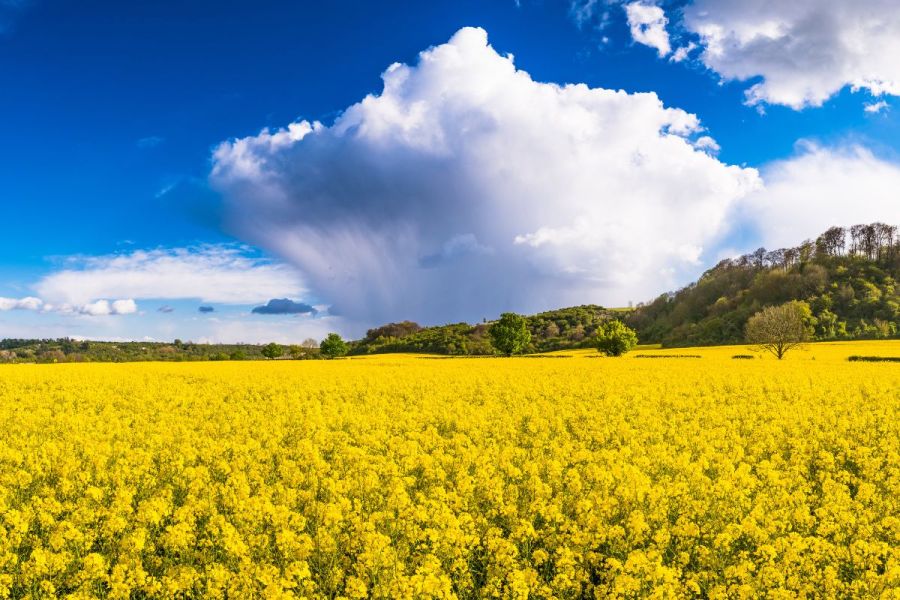It’s been almost a year since AHDB first published its new verticillium scoring system on the Recommended List, but what was involved in getting there and how do breeders feel about it? CPM delves deeper.
“Hopefully as more data is collected, this will allow for the introduction of the numerical scale.”
By Melanie Jenkins
It’s a disease which can often be misidentified, and work undertaken by AHDB, NIAB, ADAS and many plant breeders is helping to not only bring the intricacies of verticillium to growers’ attention, but to also put more power into the hands of the grower when it comes to variety selection.
Verticillium longisporium, commonly referred to as verticillium stem stripe, was first confirmed in 2007 in winter oilseed rape in the UK. It typically presents symptoms in crops as they ripen and can be present on stubbles after harvest, explains ADAS’ Philip Walker. “Although initially it was only reported sporadically, the disease has spread since 2007 with increasing reports of both new and severe infections. The most severely affected crops tend to be located in eastern England, however symptoms have been reported in other OSR cropping areas such as Lincolnshire, Yorkshire and Herefordshire.
Verticillium is a soil-borne pathogen which survives as microsclerotia on infected plant debris, says Philip. “Once incorporated into the soil it can persist for more than 10 years. When an OSR crop is planted on infected land, the root exudates of the seedlings stimulate the germination of the verticillium fungus which invades the plants through the root tissue and spreads within the plant’s vascular tissues. Typically, symptoms then present close to harvest as yellow or brown vertical stripes on the stem surface, grey or silver discolouration under the stem surface, and visible microsclerotia. When the stem debris breaks down, this returns the microsclerotia and infection back into the soil.”
The persistent nature of verticillium makes it difficult to control with rotational practices alone unlikely to be an effective control measure, he warns. “Significant yield losses have been known in periods of high temperatures and drought stress in the run up to harvest. Currently there are no fungicides available with specific label recommendations for the control of verticillium in OSR, therefore interest has been driven on the effect of varietal resistance against the disease.”
ADAS has run independent variety screening trials sponsored by breeders since 2014 – the assessment method developed for these trials showed that varietal differences for verticillium could be easily differentiated, explains Philip. “An AHDB project funded from 2016-18 validated this method and showed that variety reactions to verticillium were significantly and consistently different enough for them to be included for RL testing.”
According to AHDB’s Catherine Harries, the AHDB project came about in response to concerns raised by levy payers about the future control of verticillium in the absence of fully effective cultural or fungicidal control.
Subsequently, AHDB’s verticillium project tested and validated the assessment method for verticillium during a three-year period and provided the recommendation that the differences seen in varieties response to verticillium was great enough to enable a ratings system to be introduced, says Philip. “The methodology devised involved assessing OSR stems from early July onwards when the symptoms of verticillium are most visible and differences between varieties are easily distinguishable.”
According to Catherine, the trial sites selected are judged to have a relatively uniform distribution of the disease, with artificial inoculation used (as appropriate) to help ensure this. Each site features four replicates of each variety to minimise site variation effects.
Trial management is similar to the AHDB’s main OSR trial series, except fungicide applications are limited to a single autumn treatment targeted at stem canker. Additionally, plots aren’t harvested, as plants are pulled up early as part of the disease assessments. Crops are carefully monitored to determine the optimum assessment timing – too early or too late would potentially underestimate symptom incidence and severity.
In each plot, 30 stems are assessed for external (shredding and black microsclerotia) and internal (grey discolouration, revealed by scraping stems) symptoms, with the percentage of the stem circumference affected recorded. These are then assigned to infection classes, which are then calculated for analysis using a 0-100 index scale for verticillium infection, explains Phillip.
The 0 of the index represents no symptoms on any stem whereas 100 represents all stems severely affected or dead, adds Catherine.
Working with NIAB and ADAS allowed the project to identify consistent and reproducible differences in verticillium infection levels between varieties, says Catherine. Following this, RL trials commenced with a view to producing information in the RL from 2023.
“The initial dataset had a large LSD and our consultant statisticians didn’t think the usual 1-9 disease ratings could be robustly produced, so for the time being the information is presented in three disease-rating categories: moderately resistant (MR), intermediate (I), and susceptible (S). Those in the MR and S categories are statistically significant from each other — so growers can be fairly sure that if they grow an MR variety this will get less disease than if they grow an S variety.”
This assessment method is now used to define resistance ratings for varieties tested on the RL. The varieties currently on the RL have been included in RL verticillium trials since 2022 and up to 44 varieties have been tested across the three years altogether, explains Philip. “In each year, there has been one trial conducted by ADAS, two by NIAB and one by NPZ UK Plant Breeding, either on naturally infected land or inoculated trials. The dataset showed that there’s a clear separation between the worst and least affected varieties for verticillium infection, and the relative rankings of the varieties were consistent between sites,” he continues.
“The introduction of the rating systems gives farmers more options to consider when assessing the influence of verticillium on their land and their selection of which variety to grow. Those with a known history of verticillium infection may want to avoid growing susceptible varieties, equally, varieties with better resistance grown on land affected by verticillium are likely to show lower levels of infection, mitigate against yield losses and reduce the potential return of the disease back into the soil.
“It should be noted that the resistance data does not indicate tolerance, as it has been known for some susceptible varieties to yield well even under high disease pressure.”
According to AHDB’s Paul Gosling, there’s been a positive response to the ratings. “Although there’s limited data, they do give farmers guidance on which varieties to avoid if verticillium is a problem for them and which ones to favour.”
And while breeders are keen to see a 1-9 scale on the RL as soon as possible, this is something AHDB also has aspirations to achieve. “Sourcing more data may enable us to develop a more precise ratings system such as the 1-9 scale,” says Paul. Getting disease assessments for verticillium in the national Variety List (formerly National List) trials would be a good start, but that’s not a decision AHDB can make,” he concludes.
This article was taken from the latest issue of CPM. Read the article in full here.
For more articles like this, subscribe here.
Sign up for Crop Production Magazine’s FREE e-newsletter here.




